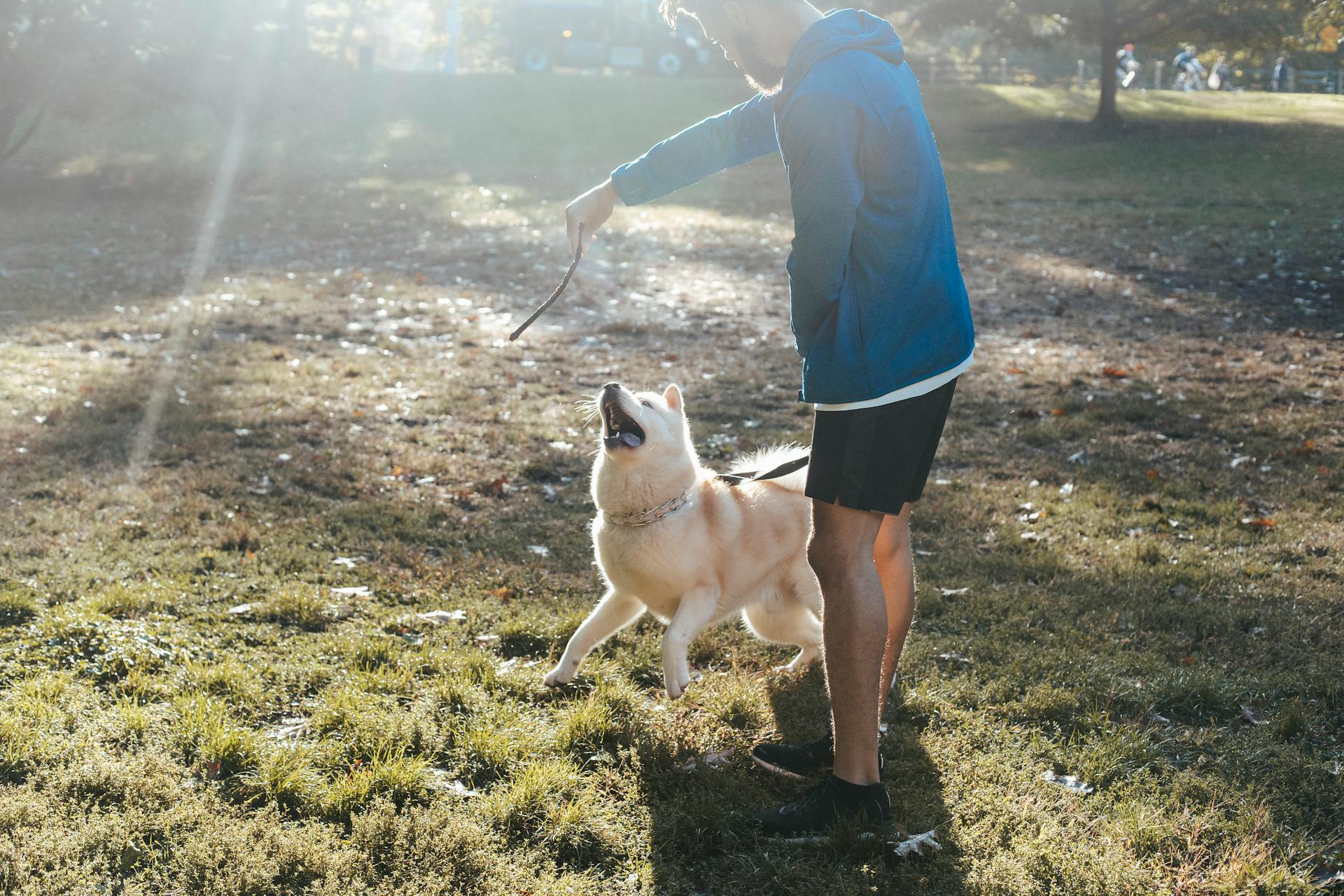
Dog aggression can be a frightening and overwhelming issue for dog owners. A professional dog trainer or behaviorist is often the best person to help you address the problem, as they can assess the situation and develop a customized plan.
The first step in treating dog aggression is to identify the underlying causes of the behavior, which may include fear, anxiety, or past trauma. This can be done through a combination of observation, interviews with the dog's owner, and sometimes even a veterinary check-up to rule out any underlying medical issues.
Some common warning signs of dog aggression include growling, snarling, and raised hackles, which can escalate quickly. If you notice any of these signs, it's essential to stay calm and not to approach the dog.
A well-structured training plan, combined with a safe and controlled environment, can help to reduce the dog's aggression and improve its behavior over time.
See what others are reading: Will Spaying Dog Stop Aggression
Causes and Diagnosis
Aggression in dogs can be caused by a variety of factors, including fear, resources, arousal, handling, redirection, predation, and social conflict.
To diagnose aggression, it's essential to identify the target and motivation of the aggression. This can help determine the best course of treatment.
Understanding the underlying cause of aggression can be complex, as a dog may view a familiar human as unfamiliar if it feels threatened or scared.
The target of aggression can be either familiar or unfamiliar, and can be influenced by the dog's past experiences and environment.
Here are some common motivations for aggression:
- Fear: often accompanied by an offensive or defensive body posture in response to proximity with another dog.
- Resources: conflict associated with resources such as food, toys, or access to spaces.
- Arousal: a state of high-excitement, such as when the doorbell rings.
- Handling: procedures like ear cleanings, nail trims, or leash clipping can trigger aggression.
- Redirection: aggression is directed at an alternate target when the original target cannot be reached.
- Predation: silent aggression directed toward smaller dogs.
- Social conflict: competition for social hierarchy between two dogs.
Aggression Caused by a Condition
Aggression can be caused by a medical condition, such as otitis externa, a common issue in dogs that can lead to resource guarding and other aggressive behaviors.
This condition can cause a dog to become irritable and protective of their resources, including toys, food, and resting spots.
Dwight D. Eisenschnauzer, a 2-year-old giant schnauzer, is a great example of this. He had a history of chronic otitis externa, which caused him to display resource guarding behavior towards other dogs in the house.
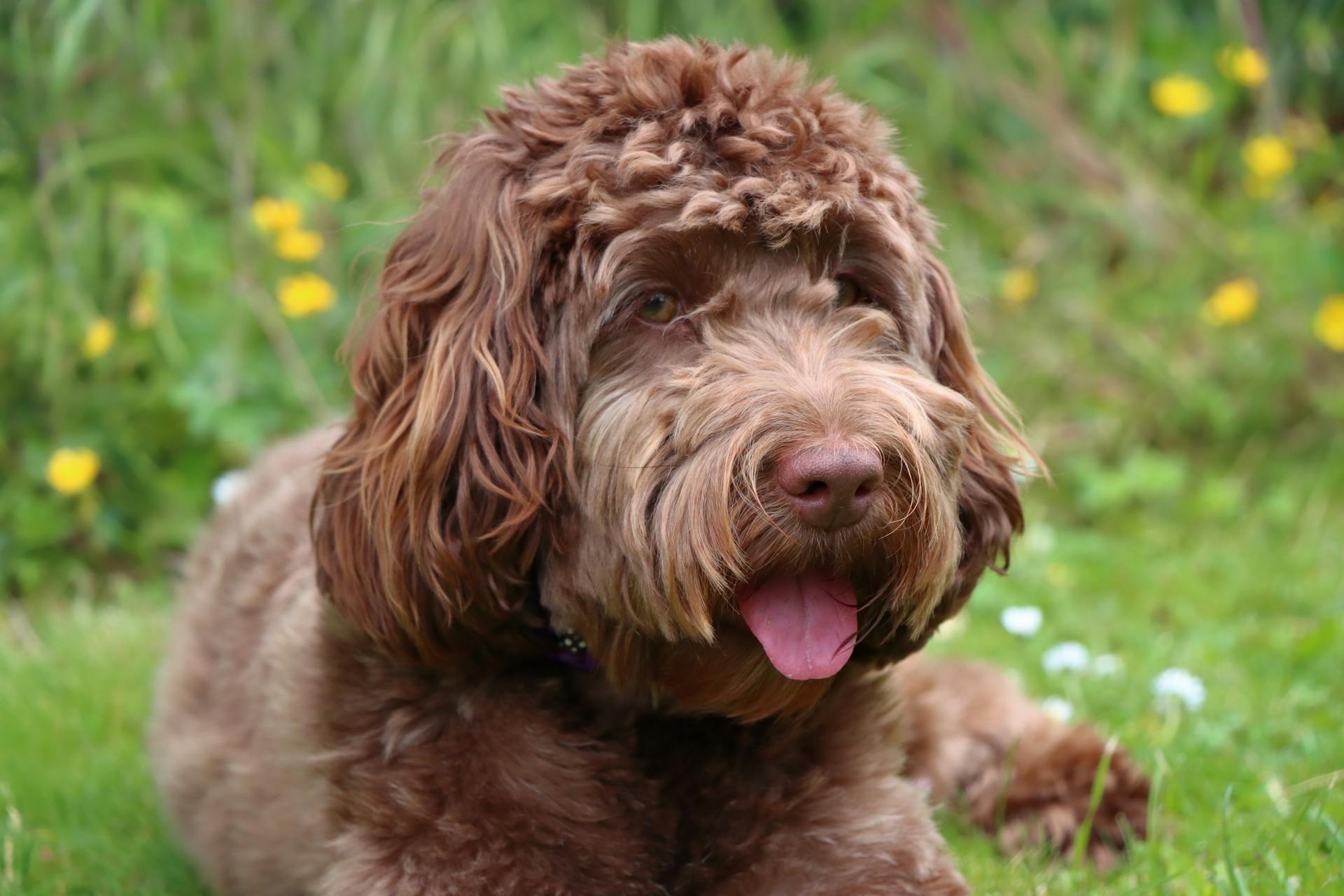
Early recognition of the medical condition and its symptoms, such as head shaking and ear scratching, is crucial in treating the underlying cause of aggression.
Treatment for interdog aggression involves managing resources, providing medical treatment for the condition, and increasing time of separation between the dogs until the condition is resolved.
By addressing the underlying medical condition, you can help reduce your dog's aggression and improve their overall well-being.
Here are some common medical conditions that can cause aggression in dogs:
- Otitis externa (ear infections)
- Chronic pain or discomfort
- Neurological disorders
- Endocrine disorders
- Other underlying medical conditions
Keep in mind that every dog is different, and what works for one dog may not work for another. Consult with a veterinarian or a certified animal behaviorist to determine the underlying cause of your dog's aggression and develop a treatment plan that's tailored to their needs.
Understanding Fear
Fear is a common underlying cause of aggression in dogs. It's not just about being scared of something, but rather a deep-seated anxiety that can manifest in different ways.
Dogs can't express their root of aggression, so pet owners are left to figure out what's going on with their dogs, making it a guessing game.
Some veterinarians suggest that pet owners look at the daily elements in a dog's life to see if any clues are surrounding the dog's aggression. This includes paying attention to when and where the aggression occurs.
Aggression can be centered around food, as some dogs may associate feeding times with being overly aggressive due to past experiences. This is indicative of food-related anxiety.
It's essential to recognize that aggression is just a symptom of a deeper issue, and treating the underlying cause is crucial. Avoiding triggers may be necessary in the initial stages of a behavior modification program, but the ultimate goal is to reduce the dog's anxiety and reactivity around those circumstances.
By understanding the root of the fear, you can start to address it and help your dog feel more confident and calm. This can be a challenging process, but with patience, love, and the right approach, it's possible to help your dog overcome their fear-based aggression.
Explore further: My Dog Has Food Aggression
Why Punishment Fails
Punishment is a flawed approach to dog aggression because it doesn't address the root cause of the behavior. It's a coping mechanism for an unpleasant internal state, often caused by anxiety, fear, pain, or frustration.
Punishment doesn't make your dog calmer or less anxious, it creates additional stress and frustration. This can push them to a point where they no longer care about the punishment when faced with a perceived threat.
Aggression is a warning signal that your dog is deeply uncomfortable, and punishing them for it can make the situation worse. Growling, snapping, lunging, and snarling are all communication attempts that should be regarded as a call for help.
In the midst of an actual attack, punishment is usually ineffective and can even contribute to the aggression. It's best to distract or physically prevent the dog from continuing to be aggressive.
Aggression typically aims to create distance between your dog and the stimulus, and when the stimulus retreats, the dog experiences relief. This behavior gets reinforced and will be repeated, making the aggression worse over time.
Treatment and Management
Management is the first step in treating dog aggression, and it begins with identifying and avoiding triggering situations. This means recognizing signs of fear, anxiety, stress, and nonverbal precursors of aggression in your pet, such as pinned-back ears, lip licking, and crouched body.
Avoidance is key, especially in situations where your dog may encounter unfamiliar dogs or humans. This can include avoiding dog parks, doggy daycare, and clinic waiting rooms, or not allowing visitors in the home unless your dog is confined in another room.
Teaching your dog to release or trade items on cue can help prevent aggression when they steal objects. You can also supervise your dog closely and be prepared to distract them. If your dog is aggressive with other dogs, physical separation is often necessary, and a head halter may provide additional control.
Regular follow-up with a veterinary behaviorist or trainer is essential to monitor progress and make adjustments to the behavior modification program. This can include rechecking evaluation every 4 weeks and assessing improvement in intensity, frequency, and recovery period after being triggered.
Management Tools for Safety Improvement
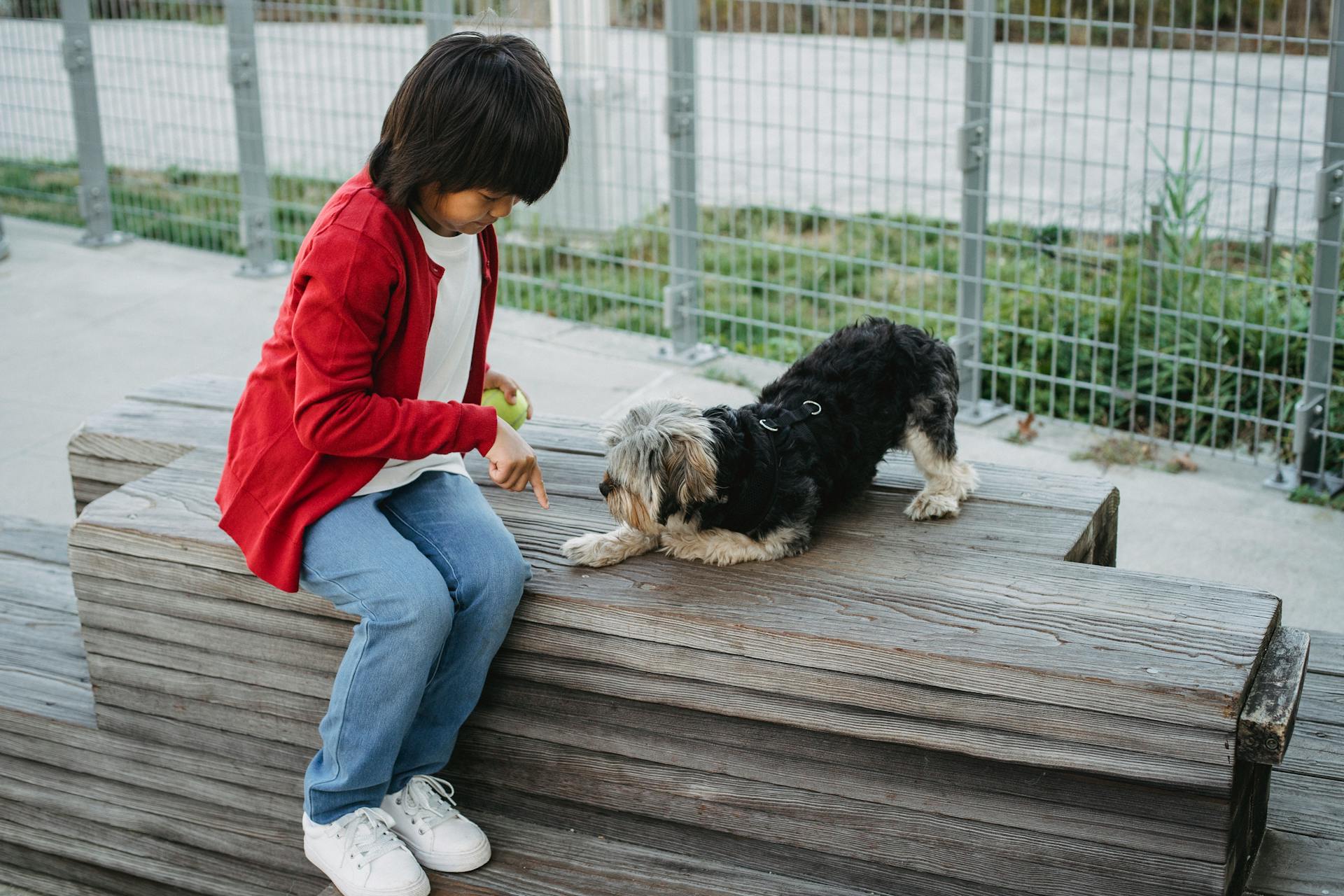
Management is the first step in a comprehensive treatment plan for aggression, and it begins with identification and avoidance of triggering situations. Owners should be able to recognize signs of fear, anxiety, stress, and nonverbal precursors of aggression in their pet.
Avoiding triggering situations can include not allowing visitors in the home unless the dog is confined in another room, taking the dog on a leashed walk during low-traffic times and in locations in which a minimal number of humans will be encountered, and crossing the street when others are approaching.
Muzzling can prevent serious injuries when aggression is triggered, but it does not prevent aggression. A basket muzzle might be helpful in certain situations, such as desensitization and controlled, supervised play with another dog.
Physical separation, such as using baby gates to confine the dog, or crate training, can also be effective management tools. Confine your dog safely until visitors have settled, and use a leash to prevent them from getting close to targeted family members.

Here are some additional management techniques to consider:
- Use a head halter for control, which can prevent lunging and steer your dog away from the situation.
- Teach your dog to release or trade items on cue to prevent aggression over stolen objects.
- Supervise your dog closely and be prepared to distract them if they start to get worked up.
- Use a long line attached to a harness to allow your dog to play while still being supervised.
- Provide undisturbed space for your dog to prevent accidental confrontations.
Remember, management is not a substitute for training, and it's essential to work with a skilled behavior professional to create a comprehensive treatment plan for your dog's aggression.
Clinical Follow-Up/Monitoring
Regular follow-up with a veterinary behaviorist, trainer, or behavior consultant is crucial to ensure the effectiveness of the behavior modification program. This should be done at least every 4 weeks.
Owners should meet with a veterinary behaviorist, trainer, or behavior consultant weekly or every other week to assess the progress of the program. This helps identify any management or medication failures.
Improvement in the intensity of the behavior, frequency of the behavior, and recovery period after being triggered should be assessed during each recheck examination. A decrease in all these areas should be seen after treatment.
In severe cases, improvement may only be seen in intensity and recovery; frequency may only be decreased with strict management.
Take a look at this: Aggression Dog Trainer
How to Calm
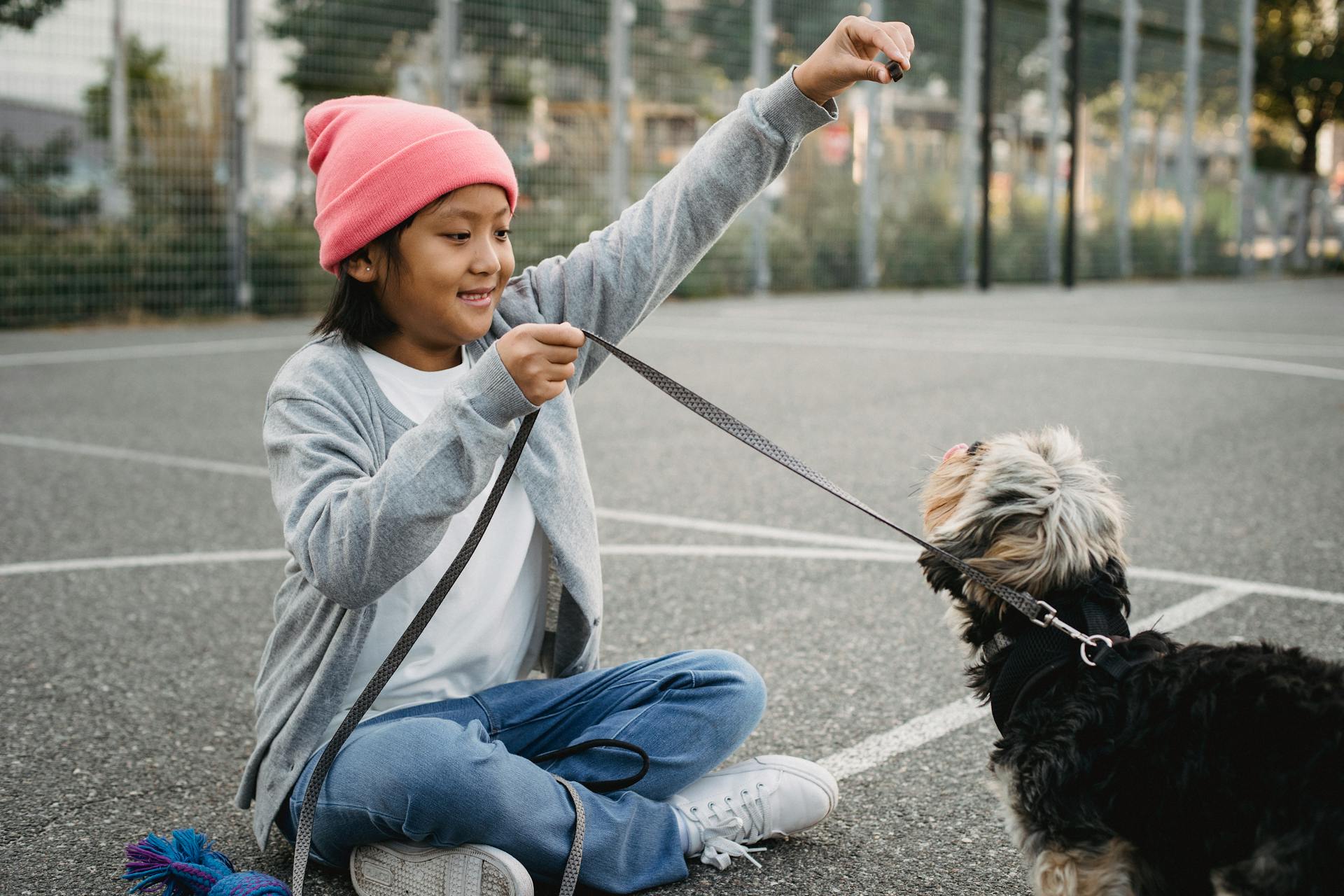
Calm your aggressive dog with the right approach. Medication can be a crucial part of treatment, but it's not always the solution. In fact, medication can sometimes make the problem worse if not used properly.
To calm an aggressive dog, it's essential to understand that high anxiety levels can hinder their ability to learn. Medication can help manage this anxiety, creating a foundation for effective behavior modification techniques.
Talk to your veterinarian or a veterinary behaviorist when you're concerned about your dog's aggression. They can assess your dog's needs and determine if medication can be a beneficial part of their treatment plan. A board-certified veterinary behaviorist or a resident in clinical behavioral medicine can also be consulted for the best protocol.
Medication can be categorized into four types: anti-anxiety medications, beta-blockers, selective serotonin reuptake inhibitors (SSRIs), and tricyclics (TCAs). Each type has its own specific effects and may not work for every dog.
A different take: How to Calm Dog Aggression

Here are some commonly used medications for treating dog aggression:
- Anti-anxiety medications, such as fluoxetine and clomipramine
- Beta-blockers, like propranolol
- SSRIs, including sertraline and paroxetine
- TCAs, including clomipramine and amitriptyline
However, it's essential to remember that every dog is different, and what works for one dog may not work for another. A professional dog trainer or behaviorist can help you determine the best course of action for your dog's specific needs.
If your dog's prescription drugs are worsening their symptoms of aggression, contact the animal behaviorist immediately. They can work with you to determine the best next steps and create a behavior modification treatment plan that yields the desired side effects.
Prevention and Safety
Proper socialization is key to preventing aggression in dogs. Socialization should occur in a safe, controlled environment when puppies are between 3 to 14 weeks of age.
To prevent harm, it's crucial to prioritize safety, especially in unpredictable situations. Your goal should be to stop biting and lunging, which means being able to quickly move your dog away from the trigger.
Muzzling your dog can prevent serious injuries, but it doesn't prevent aggression. A muzzle can still be used in situations where a head halter isn't feasible. A head halter, on the other hand, can provide more control over your dog's head movement, allowing you to prevent lunging and steer them away from the situation.
Here are some safety tips to keep in mind:
- Confine your dog safely until visitors have settled.
- Use barriers and leashes to prevent your dog from getting close to targeted family members.
- Supervise your dog at all times when outdoors, especially if you don't have a securely fenced yard.
- Provide undisturbed space for your dog to eat and play, and avoid approaching them during these times.
By following these safety tips and being proactive about prevention, you can reduce the risk of aggression in your dog and create a safer environment for everyone.
Prognosis and Prevention
Socialization in a safe environment between 3 to 14 weeks of age is crucial to prevent aggression toward other dogs.
Avoiding other dogs until after the full round of vaccinations is not recommended, as the risk of developing infectious diseases is negligible.
Clinicians must inform owners of the prognosis and risk factors associated with dogs that are aggressive toward household members.
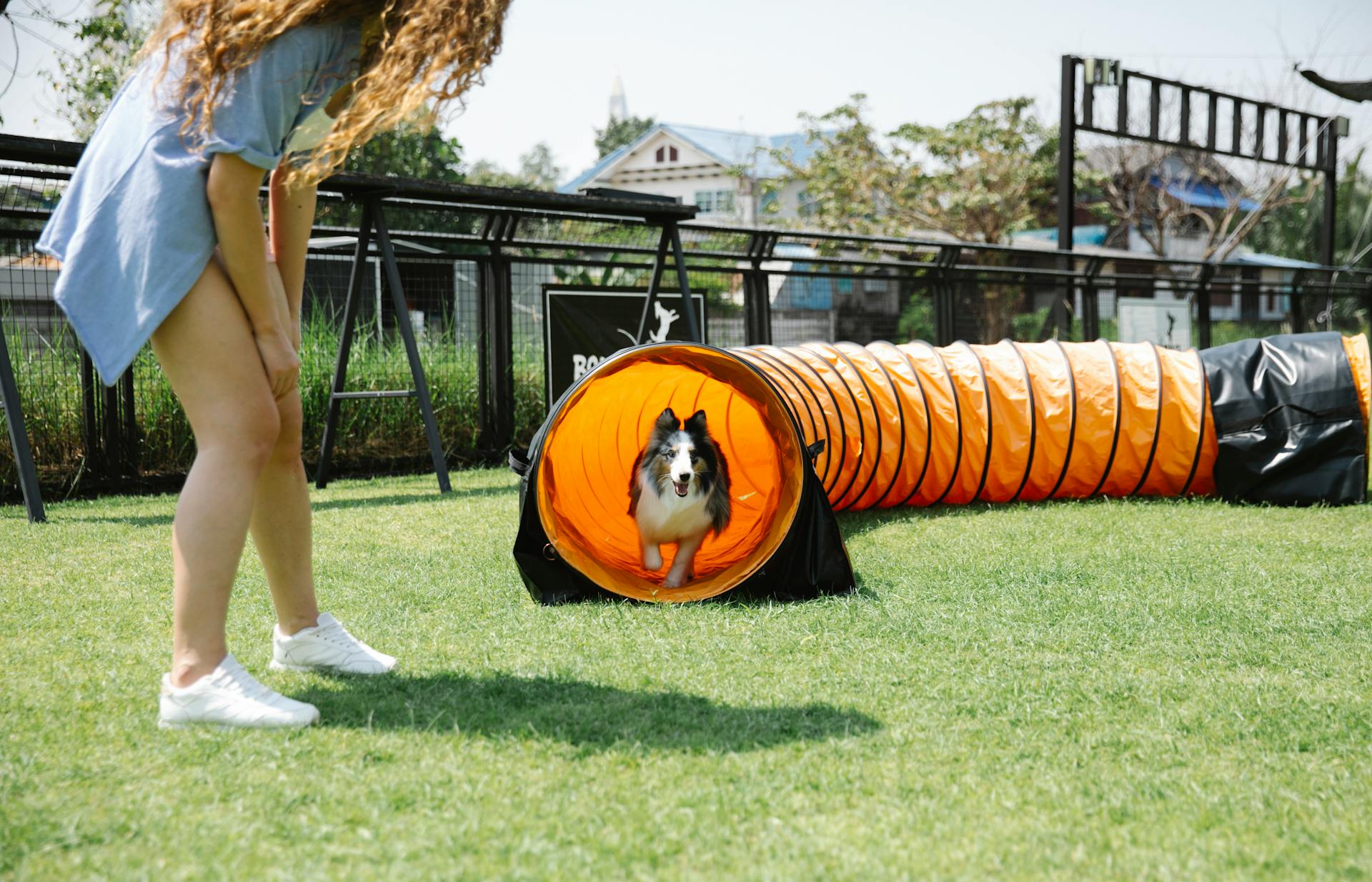
Risk factors include the family's ability to manage the dog during treatment, severity of bites, and number of bite incidents.
The size of the dog, context of the aggression, and concurrent medical disease are also important considerations.
Prognosis depends on the owner's ability to identify aggression triggers and manage them, as well as the size of the dogs involved and the dog's initial response to treatment.
Setting realistic expectations is essential for determining if treatment is feasible and assessing the possibility of rehoming the dog.
If there are children or elderly people at risk, serious consideration should be made for rehoming or euthanasia.
To manage and prevent dog aggression, avoidance is the best strategy, especially in the initial stages of treatment.
Every time your dog is exposed to situations that make them anxious, fearful, frustrated, or aggressive, the problem gets worse.
Aggression tends to escalate, making safety a critical concern.
Here are some key factors to consider when managing and preventing dog aggression:
- The family’s ability to manage the dog during treatment
- Severity of bites
- Number of bite incidents
- Members of the household (particularly those who are children, elderly, or cognitively impaired)
- Predictability of the aggression
- Size of the dog
- Context of the aggression
- Concurrent medical disease
Management and Prevention
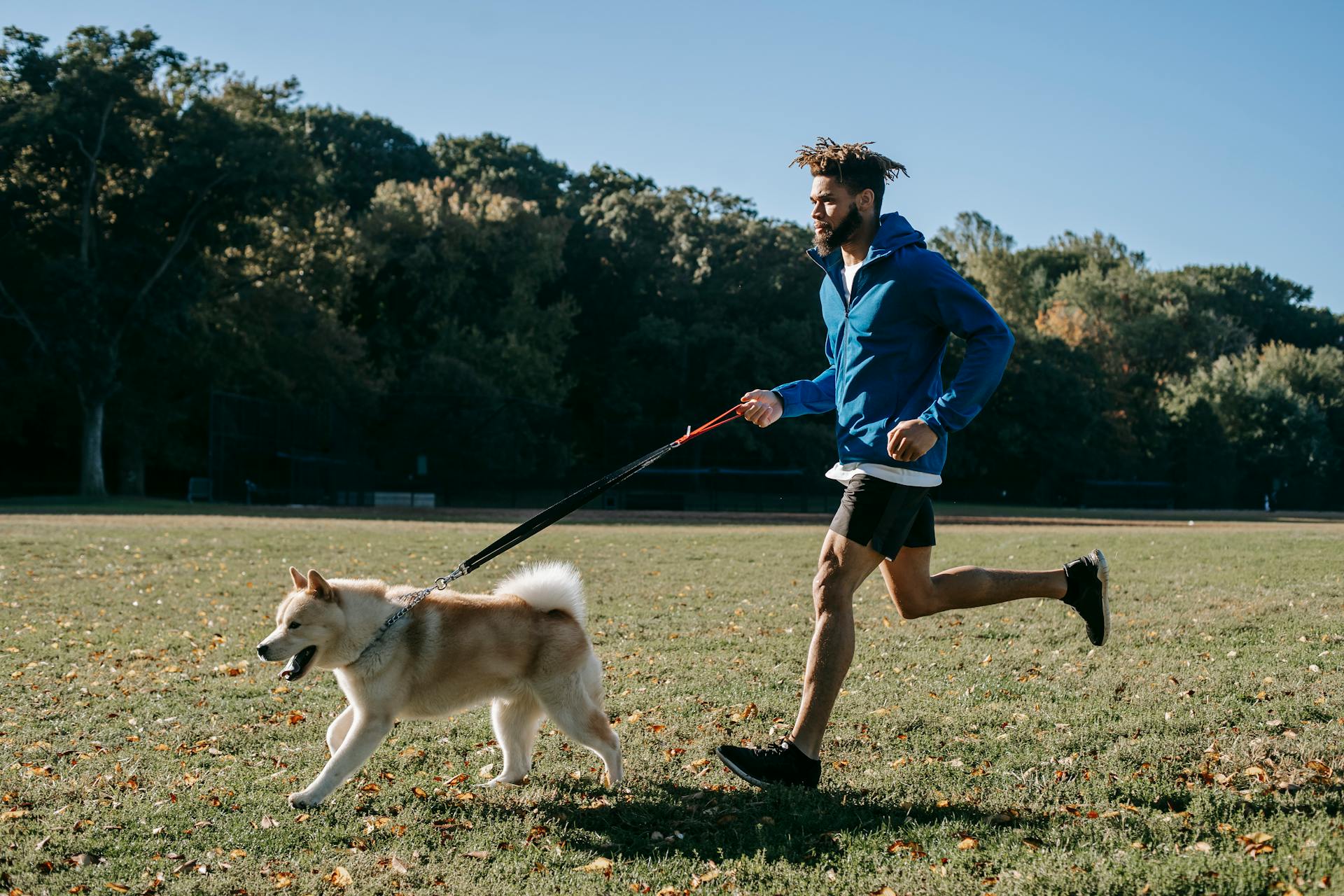
Management and prevention of dog aggression is crucial to ensure the safety of both your dog and others. By understanding the triggers and signs of aggression, you can take steps to manage and prevent it.
Avoiding triggers is the first step in management and prevention. This means identifying what causes your dog's aggression and taking steps to avoid those situations. Clinicians recommend not waiting until after vaccinations to socialize puppies, as the risk of developing infectious diseases is negligible.
You can start building a plan by getting a better idea of what's happening and why. This involves observing your dog's behavior and identifying patterns. By doing so, you can develop a strategy to manage and prevent aggression.
The goal of management and prevention is not to eliminate aggression but to prevent it from escalating. Every time your dog is exposed to situations that make them anxious, fearful, frustrated, or aggressive, the problem gets worse.
Take a look at this: Why Does My Male Dog Lick My Female Dogs Pee
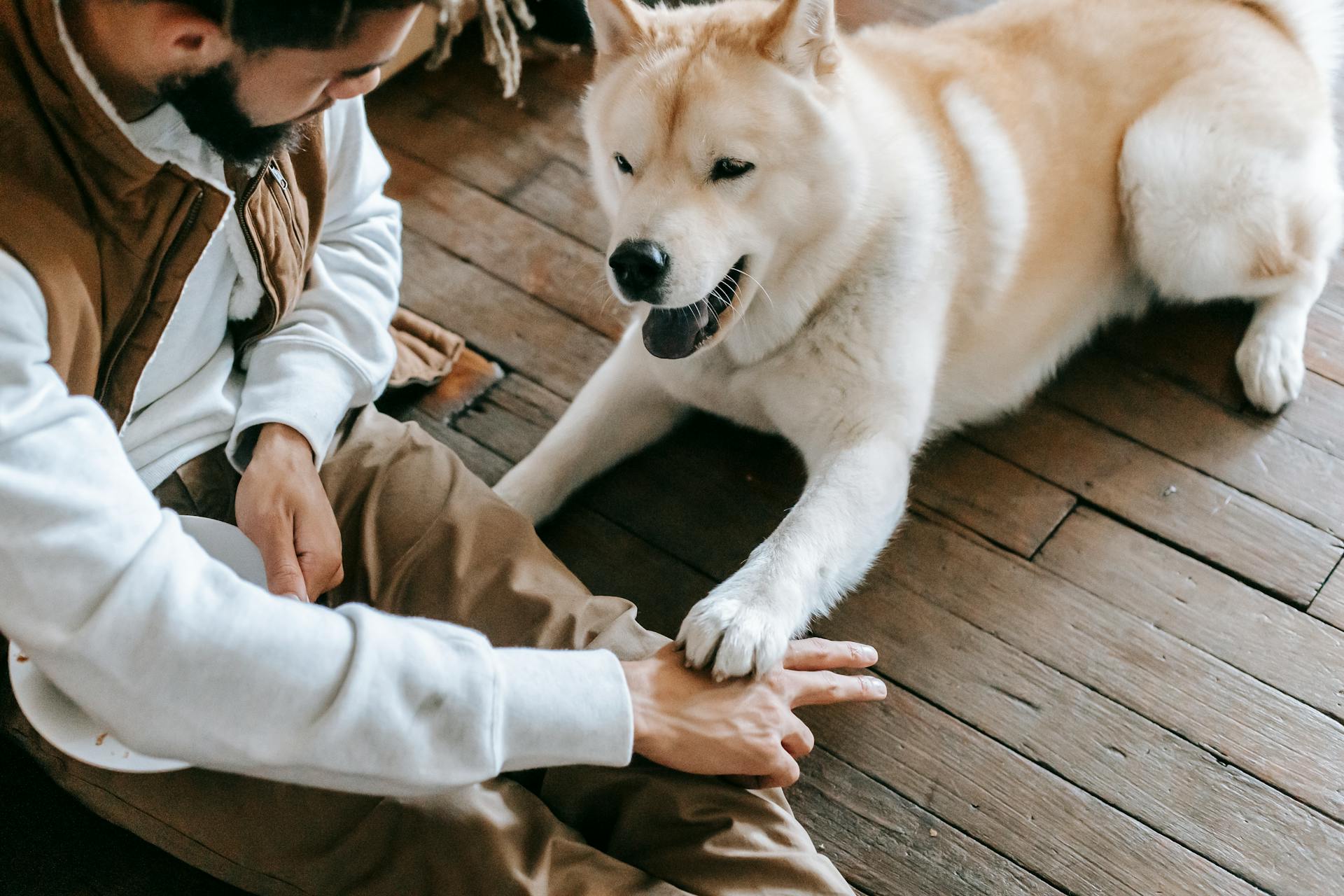
Some common triggers of aggression include:
- Leash walking during high-traffic times
- Leash walking in areas where other dogs may be encountered
- Guests bringing a dog to the home
- Conflict over resources, such as food or toys
To manage these triggers, you can use various techniques, including:
- Separating your dog from the trigger
- Using barriers, such as baby gates or crates, to confine your dog
- Teaching your dog to release or trade items on cue
- Supervising your dog closely and being prepared to distract them
- Using physical separation or a basket muzzle in emergency situations
Remember, every dog is different, and what works for one dog may not work for another. It's essential to work with a veterinary behaviorist to develop a customized plan that meets your dog's unique needs.
By understanding the triggers of aggression and taking steps to manage and prevent it, you can create a safer environment for both your dog and others.
See what others are reading: How Does Dog Flea Medicine Work
Approaches and Methods
Behavior modification is a crucial approach in treating dog aggression. This involves working with a professional, such as a board-certified trainer or veterinary behaviorist, to develop a customized plan.
Punishment-based methods are not recommended, as they can worsen the disorder and put people's safety at risk. Instead, operant conditioning and negative reinforcement can be effective in teaching a dog that certain behaviors have consequences.
Identifying triggers is key to stopping aggression problems at home. Common triggers include loud noises, such as fireworks, which can prompt some dogs into feeling threatened.
What Is Classification
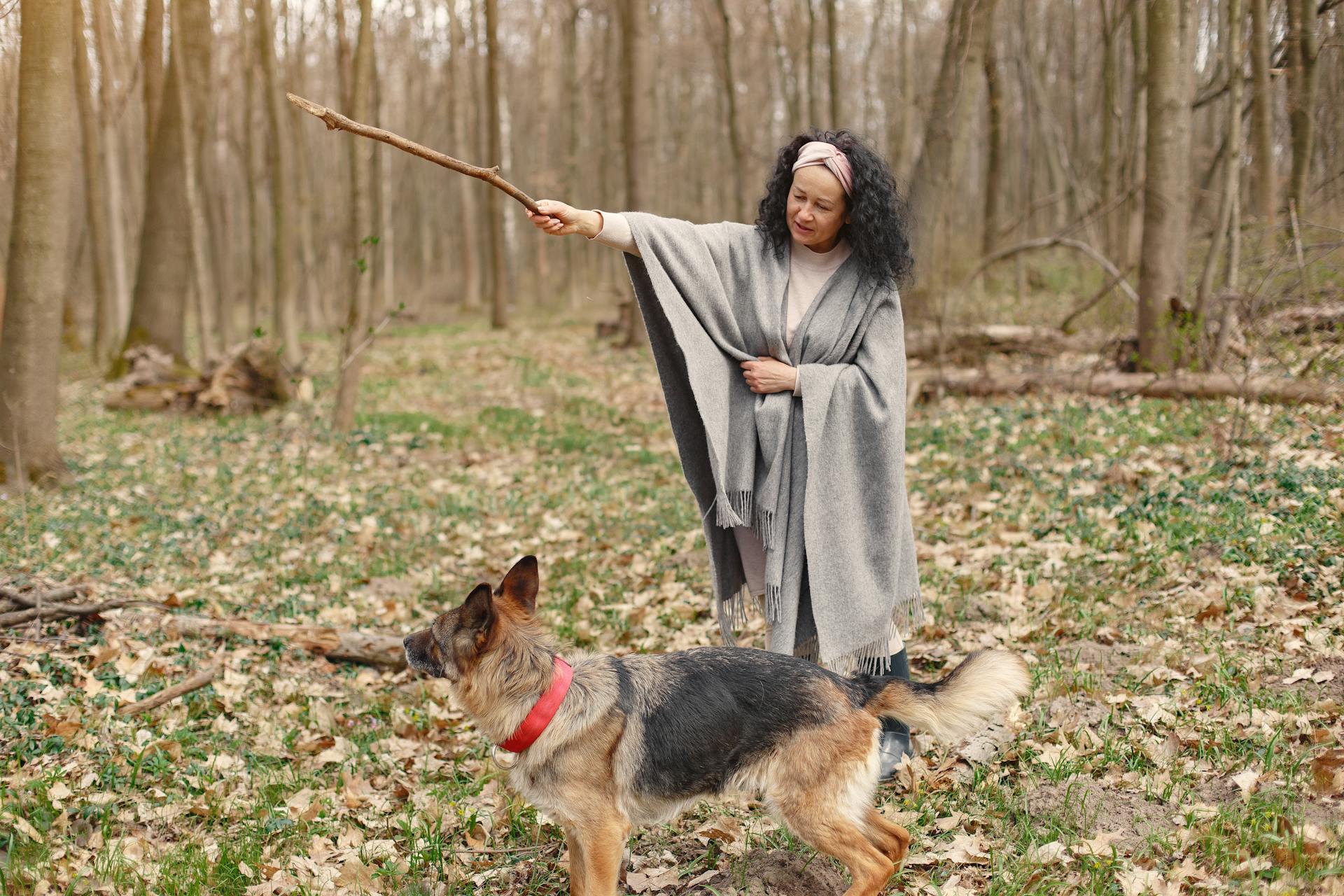
Aggression in dogs is a complex issue, but understanding the classification of aggressive behavior can help us better address the problem. Aggression is defined as hostile reactions in response to a non-threatening environment, typically without being provoked in the first place.
Aggressive behaviors in dogs are marked by a dog's need to defend himself or herself against what they view as a threat. This can be due to a perceived threat, which then causes them to act aggressively to protect themselves.
Aggressive behaviors can manifest in many different ways, ranging from slightly dangerous to uncontrollably rage-filled. Some specific examples of these behaviors include tensing up, staring intensely, and barking with force.
The intensity of the response often doesn't quite match the situation at hand, making aggressive behavior in dogs explosive and defensive. A dog may simply perceive something as a threat, causing them to act aggressively to protect themselves.
Here are some specific examples of aggressive behaviors in dogs:
- Tensing up
- Staring intensely
- Barking with force
- Squinting the eyes
- Enlarged pupil size
- Deep belly barks
- Leaning forward
- Facing the perceived threat
- Puffing out their chests
- Ramming their nose into the threatening source
- Nipping and/or biting
- Snarling and repeated barking
- Charging or cornering the threat
Punishment Methods: A Flawed Approach

Punishment is not an effective way to address dog aggression, as it can actually worsen the disorder and put the safety of the owner and others at risk.
Punishment-based trainers claim to treat aggression, but these techniques ultimately worsen the disorder. Many punishment tools, such as shock collars and choke collars, are not recommended.
Punishment doesn't make your dog calmer or less anxious, and it doesn't teach them that a perceived threat isn't real. It fails to address the root cause of the aggression.
Punishment can push dogs to a point where they no longer care about the punishment when faced with a perceived threat. This can lead to more severe aggression in the long run.
Dogs showing aggression in non-threatening situations aren't behaving normally. Treating them as simply "bad" can be dangerous.
Here are some punishment methods that are not recommended:
- Shock collars
- Choke collars
- Prong or pinch collars
- Leash popping
- Alpha rolls
- Bags of chains or cans of pennies
These methods can create additional stress and frustration for your dog, leading to more severe aggression. It's essential to focus on behavior modification and training techniques that address the root cause of the aggression.
Treatment Options
Medication can be a crucial part of treatment for dog aggression, especially when combined with behavior modification techniques.
For some dogs, medication can help manage high anxiety levels that hinder their ability to learn, creating a foundation for effective behavior modification. This is because anxiety can prevent dogs from being receptive to training and learning.
Medications like selective serotonin reuptake inhibitors (SSRIs), tricyclic antidepressants (TCAs), alpha-2 agonists, benzodiazepines, serotonin antagonist and reuptake inhibitors, and alpha-2 delta ligands can be used to treat anxiety and aggression in dogs. These medications include popular options like fluoxetine, clomipramine, and gabapentin.
While medication can be effective, it's essential to work with a veterinarian or veterinary behaviorist to determine the best protocol for your dog. They can assess your dog's needs and determine if medication can be a beneficial part of their treatment plan.
Here are the four general categories of medication used to treat behavior problems and aggressive tendencies in dogs:
- Anti-anxiety medications
- Beta-blockers
- Selective serotonin reuptake inhibitors, or SSRIs
- Tricyclics, or TCAs
Keep in mind that each dog is unique, and what works for one dog may not work for another.
Medication

Medication is a crucial aspect of treating dog aggression, and it's essential to understand how it works and what options are available.
Medication can help manage anxiety levels in dogs, creating a foundation for effective behavior modification techniques.
Not all medications are created equal, and some can even make aggression worse if not used properly.
Commonly used pharmacologic medications for dog aggression include selective serotonin reuptake inhibitors (SSRIs), such as fluoxetine and sertraline, which interact with serotonin levels in the brain.
Tricyclic antidepressants (TCAs), like clomipramine, are also used to treat aggression in dogs.
Other medications, like alpha-2 agonists (e.g., clonidine and dexmedetomidine), benzodiazepines (e.g., alprazolam and diazepam), and serotonin antagonist and reuptake inhibitors (e.g., trazodone), may also be prescribed.
Some owners may be hesitant to medicate their dogs, but medication can be a crucial part of a successful behavior modification plan.
Medication is not a quick fix, and it should be used in conjunction with other treatment options, such as behavior modification and training.
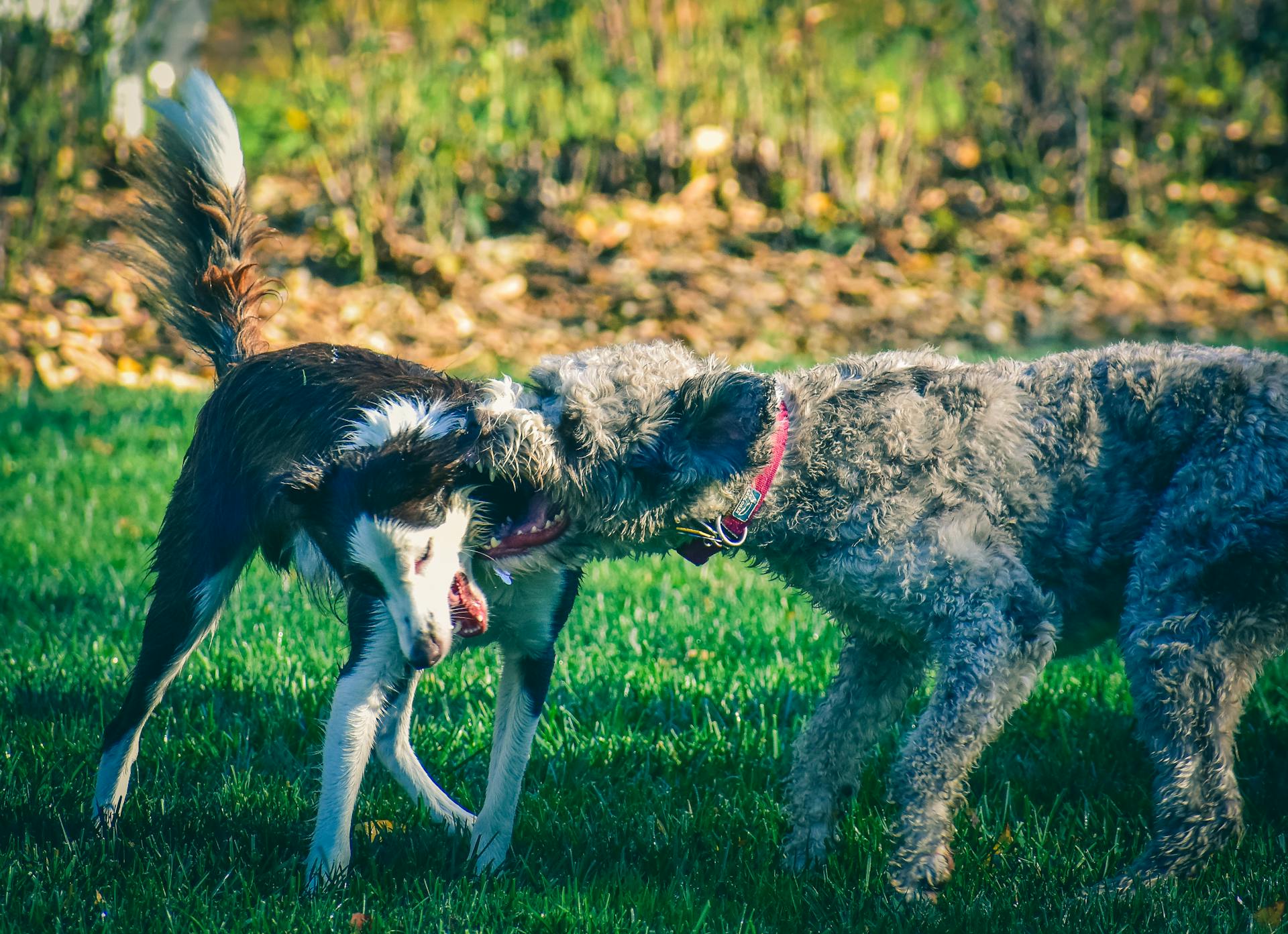
The type of medication used will depend on the individual dog's needs and circumstances.
Here are some common types of medications used to treat dog aggression:
It's essential to work with a veterinarian or a veterinary behaviorist to determine the best medication plan for your dog.
Medication can be a powerful tool in treating dog aggression, but it's not a substitute for proper training and behavior modification.
With the right medication and treatment plan, many dogs can learn to manage their aggression and live happy, healthy lives.
Canine-Directed
Canine-directed aggression is a serious issue that affects many dog owners. Several breeds, such as Jack Russell terriers, Akitas, and pit bull terriers, have been shown to exhibit a higher incidence of aggression toward other dogs.
Intact male dogs have a higher incidence of aggression as compared with neutered male dogs. This is likely due to competition for access to a female in estrus.
Dogs not socialized during the critical 3-14 week window and those not living with other dogs are more likely to have increased aggression toward unfamiliar dogs. This highlights the importance of proper socialization in preventing canine-directed aggression.
Spaying and neutering are unlikely to resolve aggression toward other dogs unless the aggression is between intact males and associated with competition for access to a female in estrus.
Curious to learn more? Check out: Canine Dysfunctional Behavior
Planning and Preparation
Creating a treatment plan for dog aggression requires the right information and support. Improving dog behavior is more complex than simply giving your dog a treat when they start showing aggression.
It's essential to find a treatment plan that is designed to improve your dog's life and keep those around safe. A good treatment plan is based on science, not charisma and storytelling.
You can take steps right now to create a plan, even before consulting an expert in dog aggression. However, some training techniques can prevent, slow down, or even make your dog worse in the long term.
For example, normal dogs might be able to cope with methods that rely on scare tactics, pain, discomfort, or intimidation, but these tactics can cause additional problems for a dog who has shown aggressive behavior.
To start, make a list of any situation where your dog has shown aggression. Include aggressive behaviors such as stares, snarls, growls, snaps, and bites. Avoid these situations for now.
Changing the environment can be an immediate step in modifying behavior. For instance, if your dog behaves aggressively during walks, change the location or time of day you walk your dog.
Aggression Types
Aggression in dogs can manifest in various forms, each with its unique characteristics and triggers. Fear-based aggression is a common type, often resulting from a dog's past experiences or environment.
Dogs with fear-based aggression may become defensive or attack when they feel threatened or cornered. They may also display warning signs such as growling, baring teeth, or raising their hackles.
Redirecting a dog's energy and providing a safe space can help alleviate fear-based aggression. By creating a calm and predictable environment, you can help your dog feel more secure and reduce the likelihood of aggressive behavior.
Redirecting a dog's energy and providing a safe space can help alleviate fear-based aggression.
Human-Directed
Spayed dogs are less likely to show aggression toward humans, regardless of familiarity. As dogs age, their likelihood of aggression toward unfamiliar humans increases.
Working dogs and hounds are more prone to aggression toward familiar humans, while gun dogs (or bird dogs) are less likely to be aggressive toward unfamiliar humans.
Dogs that attend puppy training classes are less likely to be aggressive toward unfamiliar humans, but punitive training methods can increase aggression toward both familiar and unfamiliar humans.
A dog's history and experiences play a significant role in determining their aggression, making it difficult to predict based solely on breed characteristics.
Here are some key factors to consider when assessing human-directed aggression:
- Age of onset: When did aggression begin?
- Onset speed: Was the onset sudden or gradual?
- Early warning signs: Were early warning signs (e.g., fear) observed in certain situations?
- Traumatic events: Did a traumatic event precede the onset of aggression?
Understanding these factors can help you better address human-directed aggression in your furry friend.
Aggression
Aggression can be a complex issue, but understanding the basics can help you keep both your dog and visitors safe.
Confine your dog safely until visitors have settled, and consider using a leash or confinement out of the area to prevent interactions.
If your dog can settle on a leash in the same room as visitors, have your dog settle next to you on leash, held securely by an adult family member.
Visitors should not interact with your dog until you've determined it's safe to do so, and your behaviorist can help you assess your dog's readiness.
You might like: Dog Leash Aggression
A basket muzzle can provide added safety, but visitors should not attempt to approach or pet a muzzled dog, as this can increase fear and the risk of a bite.
If your dog behaves aggressively while eating or playing, give them space and don't approach them until their meal/play time is finished.
A physical barrier can be helpful in preventing accidental confrontations, especially if your dog is a slow eater or has possessive aggression issues.
Always supervise your dog when outdoors, especially if there's a risk of aggression, and keep them leashed until training is complete if you don't have a securely fenced yard.
Never leave your dog outside unsupervised unless the yard or dog run is secure and inescapable, and ensure people can't get in or reach through the fence to access your dog.
Teach your dog to release or trade items on cue, especially if they have a tendency to become aggressive when approached after stealing objects.
Supervise your dog closely and be prepared to distract them if they start to become aggressive, and consider using a leash or confinement out of the area when you're too busy to supervise.
Use physical separation whenever there's a risk of injury, and restrain your dog on a leash to prevent them from lunging unless triggers for aggression are clear, consistent, and avoidable.
A head halter can provide additional control, and the recipient of the aggression may also need to be restrained to prevent them from approaching the dog in training.
Sources
- https://www.cliniciansbrief.com/article/canine-aggression-toward-other-dogs-humans
- https://k9aggression.com/treatment-methods/
- https://www.innovetpet.com/blogs/aggression-depression/medication-dog-aggression
- https://vcahospitals.com/know-your-pet/dog-behavior-problems---aggression---getting-started---safety-and-management
- https://www.borntoleadk9.com/dog-training-articles/aggression-in-dogs
Featured Images: pexels.com


